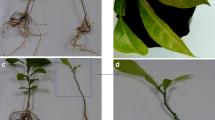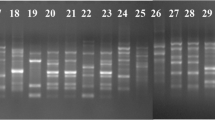Abstract
Fusarium oxysporum f. melongenae is a major soil-borne pathogen of eggplant (Solanum melongena). ISSR and RAPD markers were used to characterize Fusarium oxysporum f. melongenae isolates collected from eggplant fields in southern Turkey. Those isolates were not pathogenic to tomato. Pathogens were identified by their morphology, and their identity was confirmed by PCR amplification using the specific primer PF02-3. The isolates were classified into groups on the basis of ISSR and RAPD fingerprints, which showed a level of genetic specificity and diversity not previously identified in Fusarium oxysporum f. melongenae, suggesting that genetic differences are related to the pathogen in the Mediterranean region. The primers selected to characterize Fusarium oxysporum f. melongenae may be used to determine genetic differences and pathogen virulence. This study is the first to characterize eggplant F.oxysporum species using ISSR and RAPD.





Similar content being viewed by others
References
Alfieri SA Jr, Langdon KR, Kimbrough JW, El-Gholl NE, Wehburg C (1994) Diseases and disorders of plants in Florida. Florida Department of Agriculture and Consumer Services, Division of Plant Industry. Bulletin 14:1114
Altinok HH (2005) First report of fusarium wilt of eggplant caused by Fusarium oxysporum f. sp. melongenae in Turkey. Plant Pathol 54:577
Baayen RP, Gams W (1998) The Elegans fusaria causing wilt disease of carnation. I. Taxonomy. Netherlands. J Plant Pathol 94:273–278
Baayen RP, O’Donnell K, Bonants PJM, Cigelnik E, Kroon LPNM, Roebroeck EJA, Waalwijk C (2000) Gene genealogies and AFLP analyses in the Fusarium oxysporum complex identify monophyletic and nonmonophyletic formae speciales causing wilt and rot disease. Phytopathology 90:891
Bayraktar H, Dolar FS, Maden S (2007) Use of RAPD and ISSR markers in detection of genetic variation and population structure among Fusarium oxysporum f. sp. ciceris isolates on chickpea in Turkey. J Phytopathol 156:146–154
Biles CL, Martyn RD (1989) Local and systemic resistance induced in watermelons by formae speciales of Fusarium oxysporum. Phytopathology 79:856–860
Cai G, Gale LR, Schneider RW, Kistler HC, Davis RM, Elias KS, Miyao EM (2003) Origin of race 3 of Fusarium oxysporum f. sp. lycopersici at a single site in California. Phytopathology 93:1014–1022
Chiocchetti A, Ghignone S, Minuto A, Gullino ML, Garibaldi A, Migheli Q (1999) Identification of Fusarium oxysporum f. sp. basilici isolated from soil, basil seed, and plants by RAPD analysis. Plant Dis 83:576–581
Cho WD, Shin HD (2004) List of plant diseases in Korea, 4th edn. Korean Society of Plant Pathology, Suwon
Cline E (2009) Fusarium oxysporum f. melongenae. Systematic Mycology and Microbiology Laboratory, ARS, USDA. http://nt.ars-grin.gov/sbmlweb/OnlineResources/FungiOnline.cfm
Dubey SC, Singh SR (2008) Virulence analysis and oligonucleotide fingerprinting to detect diversity among Indian isolates of Fusarium oxysporum f. sp. ciceris causing chickpea wilt. Mycopathologia 165:389–406
Edel V, Steinberg C, Gautheron N, Alabouvette C (2000) Ribosomal DNA-targeted oligonucleotide probe and PCR assay specific for Fusarium oxysporum. Mycol Res 104:518–526
Firman ID (1972) A list of fungi and plant parasitic bacteria, viruses and nematodes in Fiji. Phytopathol Pap 15:1–36
Gregorius HR (1987) Selection in plant populations of effectively infinite size. VI. Overlapping generations. Theor Popul Biol 31:75–90
Gryta H, Carriconde F, Charcosset JY, Jargeat P, Gardes M (2005) Population dynamics of the ectomycorrhizal fungal species Tricholoma populinum and Tricholoma scalpturatum associated with black poplar under differing environmental conditions. Environ Microbiol 8:773–786
Holevas CD, Chitzanidis A, Pappas AC, Tzamos EC, Elena K, Psallidas PG, Alivizatos AS, Panagopoulos CG, Kyriakopoulou PE, Bem FP, Lascaris DN, Velissariou DE, Vloutoglou I, Analytis SC, Paplomatas EJ, Aspromougos JS, Varveri C (2000) Disease agents of cultivated plants observed in Greece from 1981 to 1990. Benaki Phytopathol Inst, Kifissia, Athens 19:1–96
Jimenez-Gasco MM, Perez-Artes E, Jimenez-Diaz RM (2001) Identification of pathogenic races 0, 1B/C, 5, and 6 of Fusarium oxysporum f. sp. ciceris with random amplified polymorphic DNA (RAPD). Eur J Plant Pathol 107:237–248
Lamboy WF (1994) Computing genetic similarity coefficients from RAPD data: the effects of PCR artifacts. Genome Res 4:31–37
Leslie JF, Summerell BA (2006) Fusarium laboratory workshops: a recent history. Mycotoxin Res 22:73–74
Lodhi MA, Ye GN, Weeden NF, Reisch BI (1994) A simple and efficient method for DNA extraction from grapevine cultivars, Vitis species and Ampelopsis. Plant Mol Biol Rep 12:6–13
Matuo T, Ishigami K (1958) On the wilt of Solanum melongena L. and its causal fungus Fusarium oxysporum f. melongenae n. f. Ann Phytopathol Soc Jpn 23:189–192
Mes JJ, Weststeijn EA, Herlaar F, Lambalk JJM, Wijbrandi J, Haring MA, Cornelissen BJC (1999) Biological and molecular characterization of Fusarium oxysporum f. sp. lycopersici divides race 1 isolates into separate virulence groups. Phytopathology 89:156–160
Mutlu N, Boyacı FH, Göçmen M, Abak K (2008) Development of SRAP, SRAP-RGA, RAPD and SCAR markers linked with a fusarium wilt resistance gene in eggplant. Theor Appl Genet 117:1303–1312
Nattrass RM (1961) Host lists of Kenya fungi and bacteria. Mycol Pap 81:1–46
O’Donnell K, Gherbawy Y, Schweigkofler W, Adler A, Prillinger H (1999) Phylogenetic analyses of DNA sequence and RAPD data compared in Fusarium oxysporum and related species from maize. J Phytopathol 147:445–452
Pizano M, Banks J (eds) (2008) Phasing out methyl bromide in Turkey. Final report
Richardson MJ (1990) An annotated list of seed-borne diseases, 4th edn. International Seed Testing Association, Zurich
Rohlf FJ (1994) NTsys: Numerical taxonomy and multivariate analysis system, version 2.02. State University of New York, Stony Brook
Sambrook J, Fritsch EF, Maniatis T (1989) Molecular cloning: a laboratory manual, 2nd edn. Cold Spring Harbor Laboratory Press, Cold Spring Harbor, NY
Siegfried LK (2000) Accurate gene diversity estimates from amplified fragment length polymorphism (AFLP) markers. Mol Ecol 9:1241–1245
Sneath PH, Sokal RR (1973) Numerical taxonomy: the principles and practice of numerical classification. W. H. Freeman, San Francisco
Steekelenburg NAM (1976) Fusarium wilt of eggplant in the Netherlands. Neth J Plant Pathol 82:191–192
Tai FL (1979) Sylloge fungorum sinicorum. Science Press, Academia Sinica, Peking
Urrutia Herrada MT, Gómez Garcia VM, Marquinaa TJ (2004) La fusariosis vascular de la berenjena en Almería. Boletín de Sanidad Vegetal, Plagas 30:85–92
Vakalounakis DJ, Fragkiadakis GA (1999) Genetic diversity of Fusarium oxysporum isolates from cucumber: Differentiation by pathogenicity, vegetative compatibility, and RAPD fingerprinting. Phytopathology 89:161–168
Voigt K, Schleier S, Bruckner B (1995) Genetic variability in Gibberella fujikuroi and some related species of the genus Fusarium based on random amplification of polymorphic DNA (RAPD). Curr Genet 27:528–535
Waalwijk C, Baayen RP, De Koning JRA, Gams W (1996) Ribosomal DNA analyses challenge the status of Fusarium sections Liseola and Elegans. Sydowia 48:90–104
Yeh FC, Yang RC, Boyle T (1999) Popgene, Version 1.31. Centre for International Forestry Research and University of Alberta. Edmonton, Alberta, Canada
Zink FW, Gubber WD (1986) Inheritance of resistance to races 0 and 2 of Fusarium oxysporum f sp. melonis of gynoecious muskmelon. Plant Dis 70:676–678
Acknowledgments
The authors wish to thank Dr. Francesco Mercati and Dr. Paolo Ruisi for their assistance with molecular studies carried out at the CNR Institute of Plant Genetics; Palermo, Italy; student F. Akay in the BATEM Molecular Biology Laboratory; technical assistant N. Karatekin for helping with studies carried out in climatic rooms; and Dr. F. Boyacı of BATEM for providing the Fusarium oxysporum f. melongenae reference isolate obtained from Italy.
Author information
Authors and Affiliations
Corresponding author
Rights and permissions
About this article
Cite this article
Baysal, Ö., Siragusa, M., Gümrükcü, E. et al. Molecular Characterization of Fusarium oxysporum f. melongenae by ISSR and RAPD Markers on Eggplant. Biochem Genet 48, 524–537 (2010). https://doi.org/10.1007/s10528-010-9336-1
Received:
Accepted:
Published:
Issue Date:
DOI: https://doi.org/10.1007/s10528-010-9336-1




